Little Barford Church Alterations and Additions
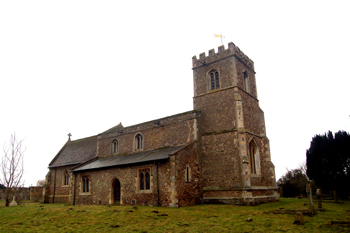
The church from the north-west February 2010
Most of the notes on the structural history of the church can be found in Bedfordshire Historical Record Society Volume number 73 of 1994 Bedfordshire Churches in the Nineteenth Century: Part I: parishes A to G, put together by former County Archivist Chris Pickford.
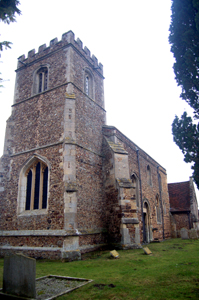
The church from the south-west February 2010
When the archdeacon carried an inspection of the church in 1669 it was in a poor state of repair. The lead needed replacing and the tower repairing [ABC7]. Churchwardens' accounts show that £48 was spent on repairs in 1824. In 1827 it was noted that the tracery in the chancel east window had been replaced by "a novel formed window in a timber frame". The archdeacon did not like this arrangement and ordered reinstatement of stone tracery in 1833.
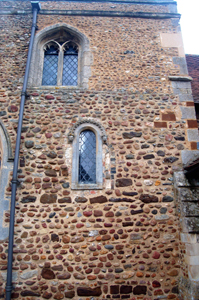
Norman window in the south wall of the nave February 2010
The south chapel was demolished in 1834 and the arches blocked up. The east wall was rebuilt in brick and a new east window was inserted. It may have been around this time that a small Norman window was re-sited in the south wall of the nave to give additional light to the reading desk.
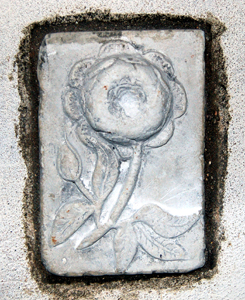
Medieval rose in the vestry February 2010
The librarian of Woburn Abbey, John Martin, who styled himself WA, wrote a number of opinionated sketches of Bedfordshire churches for the Northampton Mercury. Here is the piece he wrote on Little Barford, published on 29th May 1852: "The chancel is whitewashed, but clean. The roof ceiled, and the piscina mutilated. We are glad to find no pews here; a matter of very rare occurrence, and for which, if ugly singing galleries were removed, and great square pews pulled down, there would rarely be a necessity. On the great advantage both church and congregation would derive from this alteration, it is unnecessary to dilate".
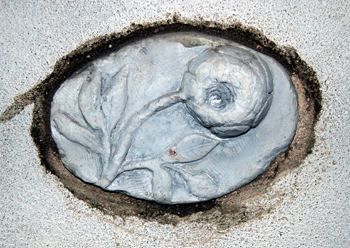
Medieval flower in the vestry February 2010
"The wood screen has escaped whitewashing, and its curious old painting has been permitted to remain".

Ornamental woodwork over the door into the vestry February 2010
"The roof of the nave is only partly ceiled - open seats prevail, save one square pew, concealing a large quantity of dirt. The font has its leaden lining, but its use appears to be superseded by a piece of crockery. We are glad to observe the western window was not blocked up, and the ringers were in sight of the congregation. We have already mentioned the advantage of their being so: and although aware that it is a very difficult matter for an incumbent to interfere with these generally troublesome gentry, yet their bad practices may, by gentle perseverance, be overcome. To those who desire this reformation, we recommend the perusal of Mr. Ellacombe's pamphlet [Practical Remarks on Belfries and Ringers by Rev. Henry T. Ellacombe of 1850]. The church is altogether in clean order, but we are sorry to see the chancel gable has been repaired with common bricks".
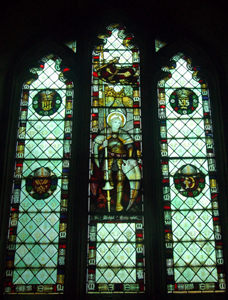
The west window February 2010
Martin's observations were timely as the church was about to change greatly. The chancel was taken down and rebuilt in 1869. At the same date the demolished south chapel was replaced with a vestry and a space for the organ. The architect was Arthur W. Blomfield [P56/0/1].
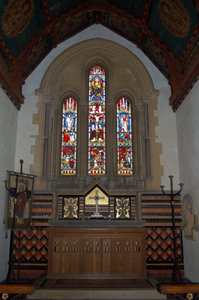
The altar and east window February 2010
The stained glass in the new chancel east window is by Clayton and Bell. It was installed in 1869 [P56/0/1]. At the same time the magnificent ceiling paintings were executed by Heaton and Butler. A mosaic reredos was installed by W. B. Simpson [P56/0/1].

Reredos February 2010
In 1871 the nave was restored [P56/0/1]. The rood screen was removed to the vestry and "the colouring restored by the Rector as nearly as possible after the original" [P56/0/1]. Following all this work the church was reopened by the Bishop of Ely on 7th November 1871 [P56/0/1].
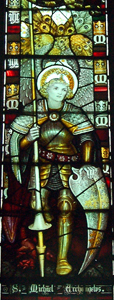
Saint Michael detail from the west window February 2010
Little Barford was never a large village and it was found uneconomic to maintain a working church. The church was, thus, closed in 1972. On 14th November 1974 it was vested in the Redundant Churches Fund.
 Saint Denys window in the north aisle west wall February 2010
Saint Denys window in the north aisle west wall February 2010